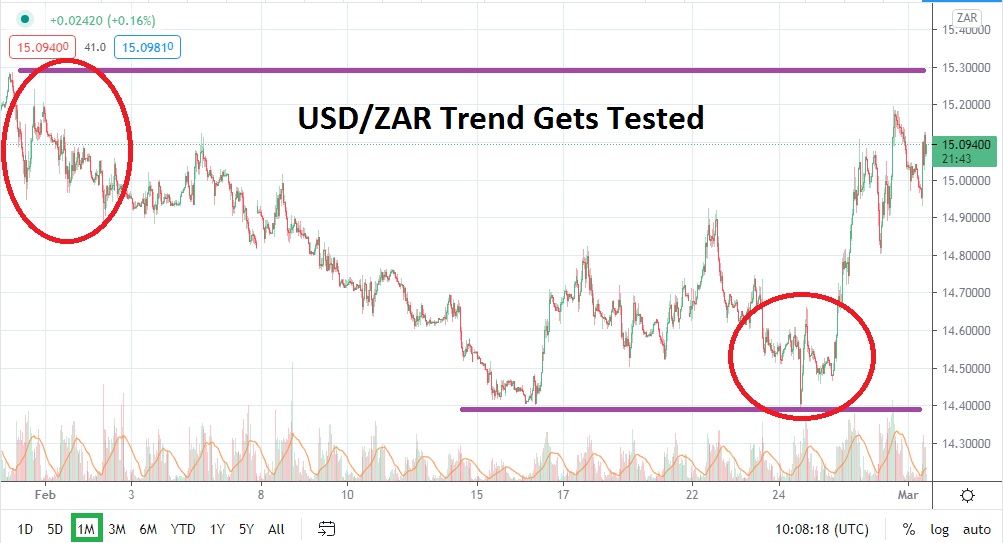The USD/ZAR opens the month of March trading above the 15.00000 juncture and this should get the attention of traders. The USD/ZAR has enjoyed a long-term bearish trend and its value below the 15.00000 has been demonstrated well the past month of trading, and a low of 14.40000 was touched on the 16th and 24th of February. The recent climb in value by the USD/ZAR has happened as a strong wave of risk-averse trading was exhibited in global Forex the end of last week.
The ability of the USD/ZAR to trade above the 15.00000 mark is intriguing, because resistance levels above this juncture have proven steadfast the past few months. Yes, in the second week of January USD/ZAR did touch the 15.60000 level, but this was short lived. Since then, the highest resistance mark tested has been around the 15.35000 juncture.
Traders should also understand that the USD/ZAR has shown a strong capability to produce bearish momentum quickly after resistance levels have proven durable. Taking this into consideration and using technical charts, there is the potential thought that the South African rand may be ready to explore bearish territory once again. The recent climb higher in price for the USD/ZAR cannot be discounted and some traders may want to explore higher resistance levels for short-term targeted buys.
However, from a risk/reward viewpoint, when technical charts are taken into consideration, the downside continues to look favorable within the current values the USD/ZAR is trading. Coupled with the notion that the USD remains within a weaker long-term stance in Forex against many major currencies, even taking into consideration last week’s risk-averse surge higher, the USD/ZAR looks attractive as a speculative sell.
It needs to also be noted that the USD/ZAR has attained its long-term bearish trend even as the price of gold is trading within the vicinity of six-month lows. The correlation between the USD/ZAR and gold has always been a favorite of fundamental traders and, if the value of the precious metal stabilizes and sees some price inflation, this could help benefit the South African rand against the USD. However, traders should be careful of reading too much into the current price of gold and the USD/ZAR.
The USD/ZAR remains a tantalizing selling opportunity for speculators. Certainly, there is a risk that the Forex pair could test resistance levels above, but the ability of these higher values to create reversals lower the past few months may be considered an additional ingredient regarding speculative wagers within the USD/ZAR to sell.
Cautious traders may want to wait for slight movements higher which test current resistance levels to activate their selling positions. However, the surge higher seen late last week actually opens the door for speculative short positions to be launched within the current price band. Needless to say, stop losses should always be used when trading, but looking for stronger bearish momentum to develop in March seems like a logical decision.
South African Rand Outlook for March:
Speculative price range for USD/ZAR is 14.31000 to 15.68000.
The 15.0000 juncture for the USD/ZAR is important short term; if the mark is broken lower, other support levels could prove vulnerable. If the 14.84000 to 14.66000 junctures prove inadequate, another test of long-term low water values could follow with the 14.40000 again targeted and below.
Resistance has proven steadfast within the USD/ZAR, but higher levels continue to stay in focus as the Forex pair proves capable of sustaining reversals. If the price of USD/ZAR becomes sustained above 15.05000, it may begin to attract speculative buying and approach higher prices. If the 15.30000 mark is toppled, a test of resistance junctures above could ensue.

